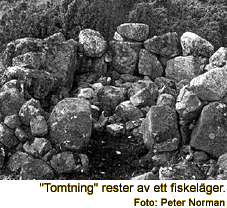Meet the Middle Ages
BackFishing

On the coast and in the archipelago, fishing has always been very important. There are traces of small settlements, where fishers have stayed during the fishing seasons in spring and autumn. These remnants are of simple dwellings, so-called "tomtningar".
There were fisher-farmers who lived permanently in the northern part of the archipelago. They made their living from fishing and a little farming. In the southern archipelago there were also fishers with permanent homes where they fished, grew crops and kept livestock.
The catch would be of herring, perch, pike, cod and salmon. Salmon was common food and one ate it often. The fish was salted and taken to be traded at the fairs in Linköping, Söder- köping, Västervik and Vimmerby. Everyone ate a lot of fish. On fast-days you were only allowed to eat fish and no meat at all.
Often, the estates or the churches in the in-lands owned the fishing-rights to the waters of the archipelago. The peasants would do the fishing, but parts of the catch had to be given to the owner; the church or the estate.